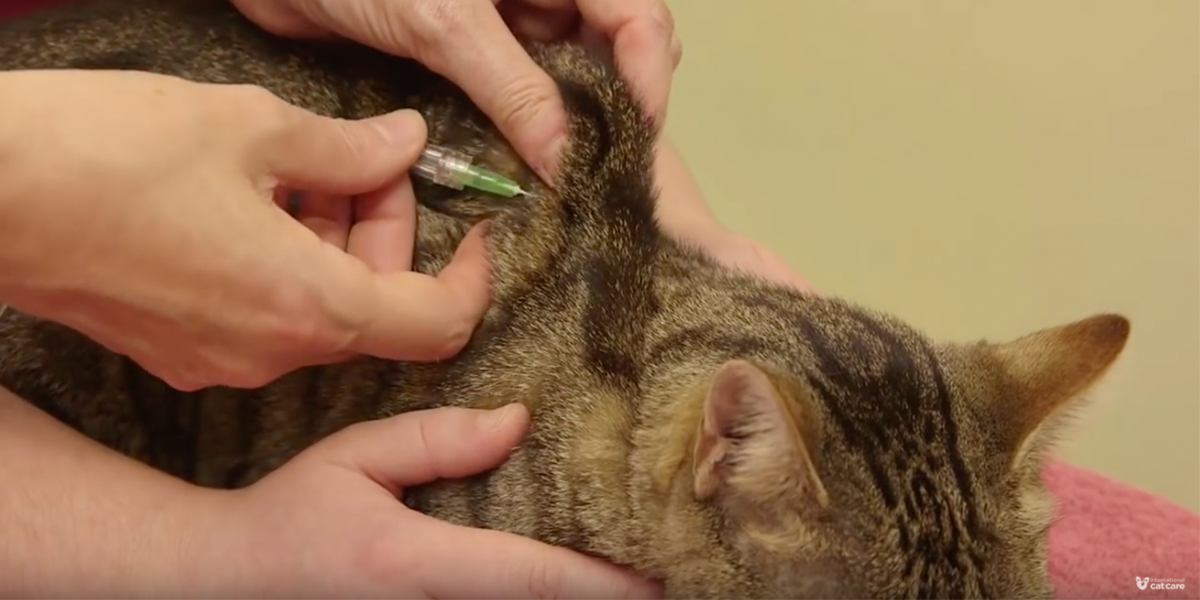Subcutaneous (SQ) fluid administration is the term used to describe giving fluids into the space under the skin (subcutaneous tissue) from where it can be slowly absorbed into the blood and body.
This is a very useful way of providing additional fluids to cats and helping to manage and prevent dehydration.
With chronic kidney disease (CKD or kidney failure), cats usually produce more urine than usual, and may become dehydrated as they may not drink sufficiently to compensate for the fluid loss. This can make the kidney disease worse, and regular SQ fluid administration can be a valuable management tool for these cats. SQ fluids may be given by your vet, but can often also be given in the home environment, with support from your vet.
How often can SQ fluids be given?
SQ fluids may be given as often as is needed, but for most cats that require fluid supplementation, they are given between once a week and once a day (with 2-3 times weekly being most common).
What fluids are used for SQ administration?
You must only use fluids given to you by your vet specifically for this purpose. The fluids are the same as those used for intravenous administration, and are sterile (free of any bacteria, viruses or fungi). Your vet will give you instructions on how much to administer and how frequently, and supply you with additional materials needed to administer the fluids (needles, tubing, etc).
The most common fluid given to cats is a balanced electrolyte solution known as ‘Hartmann’s’ or ‘Lactated Ringer’s’ solution, although others are also available.
How is the fluid given?
There are different ways to administer SQ fluids, but using a ‘drip bag’ (the bag containing the fluid for administration) and a length of ‘drip tubing’ attached to a needle which is placed under the skin is the most common method. Most cats tolerate being given SQ fluids tremendously well.
The drip bag is suspended above the level of the cat so that the fluid can run into the space under the skin under the influence of gravity. It usually takes several minutes to administer the fluid, and it is often helpful to cuddle, stroke or pet your cat during this period, or perhaps offer the cat some food to distract them.
How much fluid is given?
Your vet will tell you how much fluid to give, and whether to give it all in one place or use more than one site. Generally around 10-20 ml/kg of fluid can be given at a single SQ injection site (around 60-100 ml for an average sized cat).
A soft lump will develop under the skin at the site where the fluid has been given. This should not be painful, and the fluid is gradually absorbed over several hours. The fluid is usually given under the skin high up on the chest, but gravity will often cause the fluids to accumulate lower down on the chest or tummy. If fluid is still obvious under the skin when your cat is next due for fluids, you should check with your vet before administering any more.
Detailed instructions on fluid administration
Your vet will supply you with the fluids and equipment needed, along with specific instructions. This is designed as a general guide to help you.
Equipment
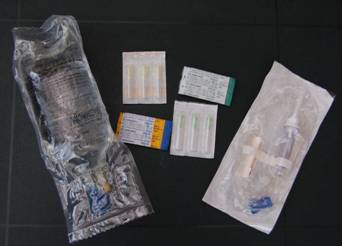
Essential equipment for administering SQ fluids includes:
- Fluid bag (note – never use fluids if they appear cloudy or discoloured)
- Giving set
- Needles
All equipment is sterile and should be supplied in sealed wrappers – these should not be opened until they are to be used
Fluid bag
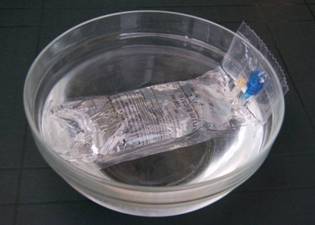
It is helpful to warm the bag of fluids by immersing it in a bowl of warm water for 5-10 minutes – warming the fluids (to make them lukewarm) helps reduce any irritation for the cat. A part-used bag of fluids can be warmed by immersing the bag in warm water, but keeping the ‘giving port’ and attached drip set out of the water.
A new bag of fluids usually comes sealed in an outer bag, which needs to be removed (after warming the fluid). At one end of the bag there will be two ‘ports’:
- An injection port for adding solutions/drugs to the fluids – you will not need to use this unless instructed by your vet
- An administration, ‘giving’ or ‘spike port’ – this usually has a blue plastic cover on it that will need to be pulled off.
Giving set
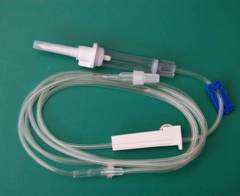
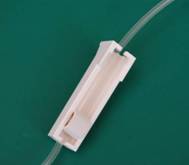
The giving set (drip set) is a long length of plastic tubing that will need to be removed from its plastic wrapping. At one end there is a plastic ‘drip’ chamber and a white spike (shielded by a removable cover). The other end (also protected by a cover) is where the needle is attached (see later).
The giving tube passes through a plastic roller clamp that serves to regulate the flow of fluids. This should be rolled down initially so that the tubing is tightly clamped to prevent fluid flowing through the tubing. There may also be a ‘pinch clamp’ that also stops any fluid flowing.
Attaching and priming the giving set
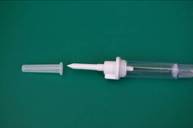
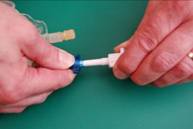
Once the clamps have been applied, the cover over the white spike can be removed. The spike is then inserted into the giving port of the fluid bag – this should be done straight on to avoid puncturing the bag. Avoid touching the white spike to prevent it being contaminated.
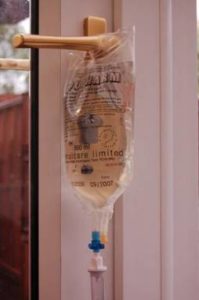
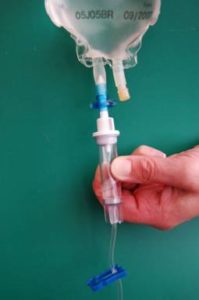
Once the giving set has been attached to the fluid bag, the bag should be hung on any suitable hook (above the height of the cat) using the plastic tab at the top of the bag. Once the bag is suspended, the drip chamber needs to be ‘primed’ – the chamber needs to be half filled with fluid, which is achieved by gently squeezing and releasing the sides of the chamber (note: make sure the clamps on the drip line are closed while this is being done).
Once the drip chamber is primed, the tubing also needs to be primed (filled with fluids), to remove all the air before it is used. With the fluid bag still suspended, the pinch clamp (if present) should be released, and then the roller clamp should be gradually released to allow a slow flow of the fluids through the tubing. You will see a steady flow of drips in the drip chamber, and you will see the fluid gradually filling the tubing. Run fluid through the tubing until all the air and bubbles are removed, and fluid is emerging from the end. When done, use the roller clamp to seal the tubing again and prevent any further flow of fluids.
Attaching the needle
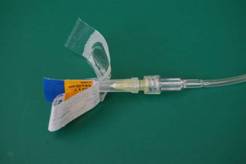

The needle can be opened by peeling apart or breaking the enclosing pack. The ‘hub’ of the needle needs to be attached to the end of the giving set, but the removable hard plastic cover over the needle itself should be left in place. Most commonly a 19, 20 or 21 gauge needle is used (this is the thickness of the needle) 1 inch in length.
The cover should be removed from the end of the giving set, and inserted firmly into the hub of the needle. Usually the needle hub has to be screwed into the end of the giving set in a clockwise direction, providing a secure attachment. Neither the hub of the needle (especially the inner part) or the protected end of the giving set should be touched during this process to make sure they do not get contaminated.
Giving the fluids to your cat
Everything is now ready for you to give fluids to your cat. Usually, it is not necessary to prepare the skin where the needle is going to be inserted, but follow any instructions from your vet.
The fluid bag should remain suspended above where your cat will be sitting. It is also important to have the cat in a comfortable position – being cuddled on your lap, or sitting beside you on the couch would be ideal. Make it as stress-free as possible for your cat by feeding or offering your cat special treats during the procedure.
The plastic cap should be removed from the needle (by pulling it off, but be careful not to stab yourself with the needle!). One hand should hold the needle at the hub (avoid touching the needle itself which would contaminate it). With the fingers of the other hand, the cat’s scruff (the skin between the shoulder blades) should be lifted to form a ‘tent’. The needle should be inserted gently and smoothly into the tent that has been formed, keeping the needle parallel with the cat’s back, so that the tip of the needle is lying in the subcutaneous space. It may be easier to place the tip of the needle next to the skin and then ‘pull the skin over the needle’ rather than ‘push the needle through the skin’.
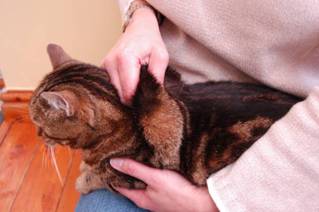
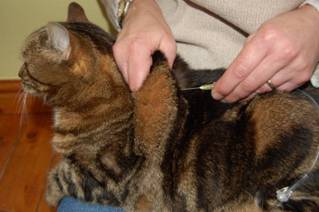
Once the needle is in place, the skin can be released, but you may need to hold the end of the drip set to keep the needle securely under the skin. It may also help to insert the needle to one side of the mid-line slightly so that the fluid accumulates on the left or right side – this is especially useful if quite large volumes of fluid need to be given, as the needle can be repositioned (removed and re-inserted if necessary) to give half the fluids on each side (your vet will tell you if this is needed).
The clamp(s) on the giving set now need be fully opened to allow the fluid to flow as quickly as possible. If the fluids are not flowing at a steady, fast rate (continuous flow seen in the drip chamber) you may need to either try slightly repositioning or tilting the needle and/or raise the bag of fluids to a higher level.
If the needle has been put straight through the skin (this is quite easy to do and a common mistake!) the cat’s fur will become wet immediately you open the clamps and it will be obvious the fluid is not going into the sub-cutaneous space. If this occurs, simply remove the needle from the skin, replace it with a new one, and repeat the procedure.
Your vet will tell you how much fluid to give. If the rate of flow of the fluid slows, again repositioning of the needle and/or raising of the bag of fluids should be tried. When the required amount has been given, the clamps on the giving set should be applied again to stop the flow of fluid, and the needle gently pulled from the skin. Your cat can then be treated as normal, and the fluids will usually be absorbed during the next few hours. There may be a small amount of fluid oozing out from the site where the needle went through the skin – this is quite normal, and there may be quite a large lump where the fluid has accumulated under the skin. This can be massaged gently to help disperse the fluid.
Needles should be discarded after use without re-capping to avoid injury and owners provided with an appropriate disposal container. A new needle should be used each time fluids are given.
In between each episode of fluid administration, the part-used fluid bag, giving line and needle (all still attached) are best stored in the fridge but in a clean, new plastic bag that is replaced each time. The whole system should be allowed to warm to room temperature for at least 1-2 hours before each use.
Each time a new fluid bag is used, a new giving set should be attached, but generally only one giving set needs to be used for each fluid bag. Old needles should be carefully placed in an appropriate disposal container, and returned to your vet for safe disposal.
Complications of fluid administration
Complications are actually very uncommon, but if there is anything you are concerned about, seek advice from your vet without delay. If your cat develops a persistent swelling at the site of injection, and especially if this becomes hard, warm and painful, this could indicate some local infection (abscess) that will require treatment.
Thank you for visiting our website, we hope you have found our information useful.
All our advice is freely accessible to everyone, wherever you are in the world. However, as a charity, we need your support to enable us to keep delivering high quality and up to date information for everyone. Please consider making a contribution, big or small, to keep our content free, accurate and relevant.
Support International Cat Care from as little £3
Thank you.
Donate Now


